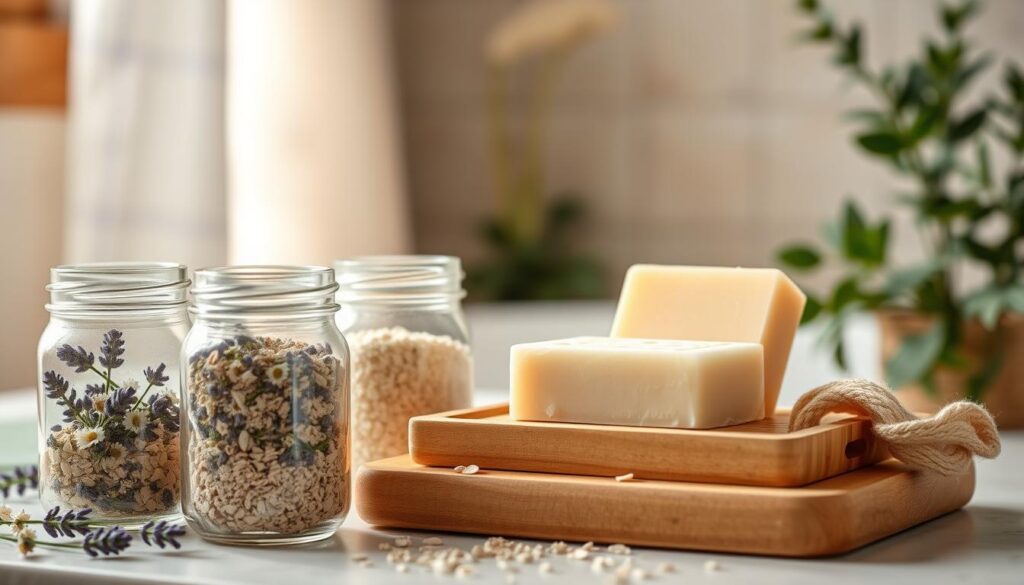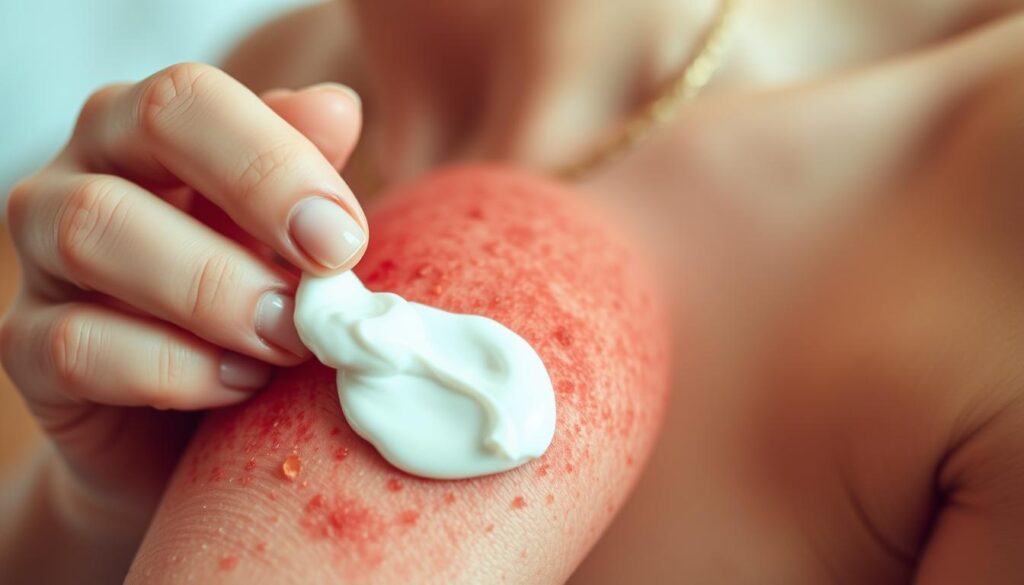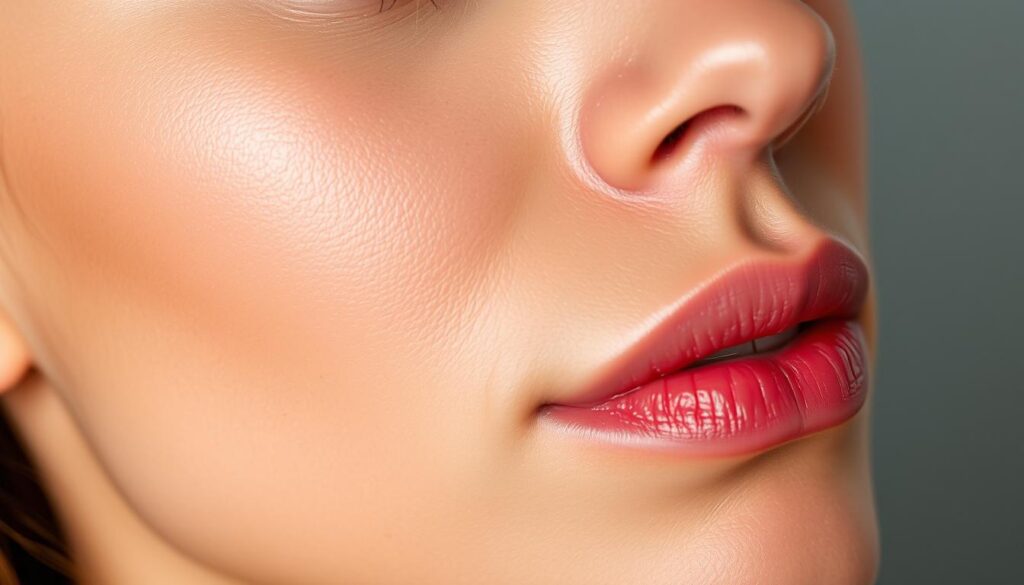Living with skin concerns can be challenging, but understanding your condition is the first step toward effective care. A consistent routine and the right products can make a significant difference in how your skin feels and looks. Psoriasis, a chronic immune condition, often requires tailored approaches to manage symptoms and reduce discomfort1.
Choosing the right treatment is crucial. Whether it’s topical solutions or lifestyle adjustments, finding what works for your skin type can help minimize flare-ups and soothe irritation. Research shows that daily sunscreen application, for example, can prevent triggers and protect your skin2.
Small changes in your routine, like limiting shower time to 5 minutes or using fragrance-free moisturizers, can also have a big impact1. By taking proactive steps and understanding your skin’s needs, you can create a plan that works for you.
Understanding Psoriasis and Its Triggers
Understanding your skin’s unique needs is key to finding relief and maintaining comfort. This condition, which causes scaly and itchy patches, can vary from person to person. Recognizing how it affects your skin is the first step toward managing it effectively3.
What Is Psoriasis and How It Affects Your Skin
Psoriasis is an autoimmune condition that speeds up the skin cell renewal process. Instead of the usual 28-30 days, new cells form every 3 to 4 days, leading to thick, scaly patches4. These patches can be itchy, painful, and sometimes even crack or bleed. Understanding this process helps you see why a consistent routine is so important.
For many, symptoms can range from mild to severe. Some people experience flare-ups that last for weeks, while others may have periods of clear skin4. Keeping track of your symptoms day by day can help you identify patterns and triggers.
Identifying Common Flare-Up Triggers
Flare-ups can be triggered by various factors. Stress, for example, is a common cause, affecting about 60% of individuals with this condition4. Weather changes, especially cold and dry air, can also worsen symptoms3.
Other triggers include skin injuries, infections, and certain medications. For instance, a cut or scrape can lead to a flare-up within 10 to 14 days5. Even something as simple as shaving can cause a reaction. Knowing these triggers helps you take preventive steps.
Using the right moisturizer daily can make a big difference. It helps soothe your skin and reduce the risk of flare-ups. By paying attention to your body’s reactions, you can create a plan that works for you.
Effective Moisturizing Techniques for Psoriasis
Proper hydration is essential for maintaining healthy skin and reducing discomfort. A consistent moisturizing routine can help reduce symptoms and improve your skin’s overall health. By choosing the right products and techniques, you can create a stress-free routine that works for you6.
Choosing the Best Moisturizer for Your Skin Type
Selecting the right moisturizer is crucial. Fragrance-free options are ideal, as they minimize the risk of irritation. Depending on your skin’s dryness, you can choose from ointments, lotions, or creams. Ointments are thicker and provide intense hydration, while lotions are lighter and absorb quickly7.
Avoid products with alcohol, as they can dry out your skin and worsen symptoms. Over a week, you’ll notice how the right moisturizer can help reduce discomfort and improve texture. Here’s a quick comparison to guide your choice:
| Product Type | Best For | Key Benefit |
|---|---|---|
| Ointment | Very Dry Skin | Deep Hydration |
| Cream | Moderate Dryness | Balanced Moisture |
| Lotion | Light Hydration | Quick Absorption |
Post-Shower and Bath Application Tips
Applying moisturizer immediately after a shower or bath is key. This locks in moisture and prevents dryness. Limit your shower time to 5 minutes and use lukewarm water to avoid stripping natural oils7.
Pat your skin dry gently, leaving it slightly damp. Then, apply your moisturizer in upward strokes. This technique not only hydrates but also reduces stress on your skin. Consistency is key—doing this daily can help reduce flare-ups over time6.
By following these steps, you can create a routine that keeps your skin healthy and comfortable. Avoiding alcohol-based products and focusing on hydration will make a noticeable difference in just a week.
Psoriasis Skincare: Managing Flare-Ups and Irritation
Finding the right treatment for your skin can make a world of difference in your daily comfort. Topical options are a cornerstone of care, offering targeted relief for irritation and scaling. Whether you’re exploring over-the-counter products or prescription solutions, understanding your choices is key to building an effective routine8.
Topical Treatment Options You Can Rely On
Topical treatments like corticosteroid creams and vitamin D analogs are widely used to manage inflammation and slow skin cell production8. These products work at the cellular level, helping to calm flare-ups and restore your skin’s balance. For example, studies show that nearly 80% of patients report itching relief with consistent use of these medications8.
Incorporating these treatments into your skin care system is simple. Apply them after a warm bath or shower to maximize absorption. This way, you lock in moisture and enhance their effectiveness. Remember to follow the instructions carefully to avoid overuse or irritation9.
Over-the-Counter vs. Prescription Solutions
Over-the-counter options like hydrocortisone creams are great for mild cases. They’re easy to access and can provide quick relief. However, for more severe symptoms, prescription medications like biologics may be necessary. These target specific parts of the immune system to reduce inflammation and prevent flare-ups8.
Choosing the right medication depends on your skin’s needs. Consulting a healthcare provider can help you decide the best way forward. They can also guide you on how to integrate these treatments into your daily system for consistent results9.
By exploring these options, you can create a skin care routine that works for you. Whether it’s an OTC cream or a prescription solution, the right treatment can help you feel more comfortable and confident in your skin.
Natural Home Remedies and Bath Solutions
Natural remedies can be a gentle yet effective way to support your skin’s health. Many people find relief by incorporating simple, home-based solutions into their daily routine. These methods not only soothe but also help maintain comfort during challenging times.

Creating a Soothing Warm Bath Routine
A warm bath can be incredibly calming for your skin. Adding ingredients like finely ground oatmeal or Epsom salts can reduce dryness and flaking. These natural elements work to hydrate and soothe, making them a great addition to your care routine10.
Here’s a quick guide to choosing the right bath ingredients:
| Ingredient | Benefit | Best For |
|---|---|---|
| Oatmeal | Reduces itching and inflammation | Sensitive Skin |
| Epsom Salt | Relaxes muscles and softens skin | Dryness |
| Dead Sea Salt | Mineral-rich, reduces scaling | Flaking |
Limit your shower or bath time to 5-10 minutes to avoid stripping natural oils. This simple step can make a big difference in how your skin feels11.
Gentle Cleansing Practices for Sensitive Skin
Using gentle cleansers is essential for maintaining healthy skin. Avoid harsh chemicals that can strip moisture and cause irritation. Instead, opt for fragrance-free, hypoallergenic products that support your skin’s natural barrier10.
After cleansing, pat your skin dry gently and apply a moisturizer while it’s still damp. This locks in hydration and helps reduce discomfort. Consistency in your care routine is key to seeing long-term results11.
By following these steps, you can create a soothing and effective routine at home. These remedies also help reduce irritation caused by environmental triggers, making them a valuable part of your daily life.
Lifestyle Changes to Reduce Psoriasis Flares
Making small changes in your daily habits can significantly improve your skin’s health. By focusing on stress reduction and dietary adjustments, you can lower the risk of flare-ups and feel more in control of your condition. These tips are designed to help you build a balanced routine that supports your overall well-being.
Stress Reduction and Relaxation Techniques
Stress is a common trigger for flare-ups, with over 70% of individuals reporting it as a major factor12. Incorporating relaxation techniques like yoga, meditation, or deep breathing into your routine can help. These practices not only reduce stress but also improve your mental and physical health.
For example, setting aside 10 minutes daily for mindfulness exercises can make a big difference. Consistency is key—over time, these habits can lower inflammation and promote a sense of calm13.
Dietary Adjustments for Inflammation Control
Your diet plays a crucial role in managing inflammation. Studies suggest that anti-inflammatory foods like leafy greens, fatty fish, and nuts can help reduce symptoms12. On the other hand, limiting sugar, processed foods, and alcohol can lower the risk of flare-ups14.
Here’s a quick guide to dietary changes that can support your skin:
- Incorporate omega-3-rich foods like salmon and walnuts.
- Avoid high-fat and sugary snacks that can worsen inflammation.
- Stay hydrated by drinking plenty of water throughout the day.
By making these adjustments, you can create a routine that not only manages your condition but also boosts your overall health.
Managing Scalp and Body Psoriasis
Dealing with scalp and body concerns requires a focused approach to maintain comfort and health. Targeted treatments can make a significant difference in reducing discomfort and improving your daily routine. By understanding the unique needs of these areas, you can choose the right products and techniques for effective care.
Targeted Treatments for Scalp Challenges
Scalp concerns often require specialized care due to hair interference. Medicated shampoos and scalp gels are effective solutions, designed to penetrate deeply and provide relief at the cellular level15. These products help reduce scaling and itching, making them a key part of your routine.
When choosing treatments, opt for products without harsh fragrance. This minimizes irritation and keeps your scalp calm. For example, shampoos containing clobetasol propionate can be used daily for up to four weeks, offering consistent benefit15.
Quick application techniques are also essential. Spending just a minute massaging the product into your scalp ensures it reaches the affected areas. This method not only saves time but also enhances the treatment’s effectiveness16.
| Product Type | Key Benefit | Best Use |
|---|---|---|
| Medicated Shampoo | Reduces scaling and itching | Daily or as needed |
| Scalp Gel | Deep penetration for relief | Post-shower application |
| Fragrance-Free Cream | Minimizes irritation | For sensitive areas |
These treatments work at the cellular level to keep skin healthy and resilient. Consistency is key—incorporating them into your daily routine can lead to noticeable improvements over time15.
By focusing on these strategies, you can effectively manage scalp and body concerns. The right products and techniques will help you maintain comfort and confidence in your daily life.
Professional Guidance and Long-Term Treatment Strategies
Working closely with a healthcare provider can transform how you approach your condition. Professional guidance ensures you’re making informed decisions about your care. Regular checkups and open communication help monitor progress and adjust treatments as needed17.
Collaborating with Your Healthcare Provider
Your provider can help you choose the best option for your needs. Whether it’s topical treatments or advanced therapies like biologics, their expertise ensures you’re on the right path17. For example, methotrexate has been used for over 40 years to treat severe cases, offering proven results17.
Patch therapies are another effective option. These deliver medication directly to affected areas, reducing symptoms like itching and scaling. Regular follow-ups allow your provider to track progress and make necessary adjustments18.
Balancing Medication with Daily Care Routines
Combining medication with a consistent daily routine maximizes results. For instance, using sunscreen daily can prevent additional psoriasis flare-ups by protecting your skin from UV rays18. Here’s a quick guide to balancing treatments:
| Treatment Type | Daily Care Tip | Benefit |
|---|---|---|
| Topical Creams | Apply after showering | Locks in moisture |
| Biologics | Follow injection schedule | Reduces inflammation |
| Phototherapy | Use sunscreen post-treatment | Prevents UV damage |
Monitoring your symptoms is key. Keep a journal to track triggers and improvements. This helps your provider tailor your treatment plan for long-term success18.
By partnering with your healthcare team, you can manage your condition effectively. Their guidance ensures you’re using the right option and maintaining a balanced routine for lasting relief.
Additional Tips for Daily Psoriasis Care
Taking small steps in your daily routine can make a big difference in how your skin feels. By incorporating protective measures and avoiding common irritants, you can reduce discomfort and maintain healthier skin. Here are some practical tips to help you stay on track.
Incorporating Sunscreen and Avoiding Irritants
Using a broad-spectrum mineral sunscreen with SPF 30 or higher is essential for protecting your skin from sunburn-induced flare-ups19. Apply it daily, especially when spending time outdoors. This simple step can prevent additional triggers and keep your skin calm.
Avoiding irritants is equally important. Fragrances, alcohol, and harsh chemicals in skincare products can worsen symptoms19. Opt for fragrance-free, hypoallergenic options to minimize the risk of irritation. For example, laundry soaps with gentle formulas are a better choice for sensitive skin.
Dietary Adjustments and Coal Tar Products
Your diet can influence flare-ups. Anti-inflammatory foods like leafy greens, fatty fish, and nuts can help reduce symptoms. On the other hand, limiting sugar and processed foods can lower the risk of flare-ups. Staying hydrated is also key to maintaining healthy skin.
Products containing coal tar (0.5% to 5%) are effective for managing symptoms19. These treatments help reduce scaling and itching, making them a valuable addition to your routine. Use them as directed to avoid overuse or irritation.
By following these tips, you can create a daily routine that supports your skin’s health. Small changes, like using sunscreen and avoiding irritants, can have a big impact over time.
Conclusion
Your journey to healthier skin starts with understanding and consistency. A balanced therapy plan, combined with professional guidance, is key to managing your condition effectively. Regular checkups and open communication with your healthcare provider ensure you’re on the right path20.
Healthy lifestyle choices, like stress management and a nutritious diet, support your immune system and reduce flare-ups. Studies show that consistent hydration and anti-inflammatory foods can improve your skin’s health over time21.
By staying proactive and working with your healthcare team, you can feel confident in your care routine. Remember, ongoing support is crucial for long-term success and overall well-being.



